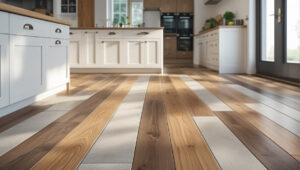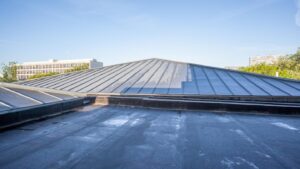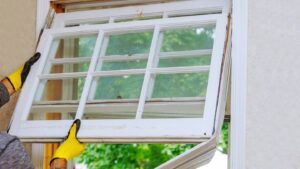Flat roofs are a popular choice for both residential and commercial properties thanks to their sleek, modern appearance and space-saving advantages. However, due to their minimal pitch, they’re also more prone to water-related issues than sloped roofs. That’s why flat roof waterproofing is one of the most important investments you can make for your property. Without proper waterproofing and maintenance, even minor flat roof problems can turn into costly repairs.
In this guide, we’ll dive into proven waterproofing flat roof techniques, essential flat roof maintenance tips, and strategies to prevent flat roof leaks while ensuring long-lasting roof protection.
Why Waterproofing Is Essential for Flat Roofs
The main challenge with flat roofs is drainage. Unlike pitched roofs that naturally allow rain to run off, flat roofs often collect water, which can pool and seep into the roofing materials over time. If not addressed, this can lead to leaks, structural damage, and even interior mold growth.
Waterproofing a flat roof serves as a protective barrier between your building and the elements. By applying a reliable waterproof system, you can extend your roof’s lifespan, prevent interior water damage, and maintain the overall structural integrity of your home or building.
Flat roof waterproofing is especially critical in areas with heavy rainfall, high humidity, or extreme temperatures, all of which can accelerate roof degradation if the surface isn’t properly protected.
How to Waterproof a Flat Roof: Proven Techniques
Understanding how to waterproof a flat roof begins with choosing the right materials and techniques tailored to your roof’s specific design, age, and usage. Several effective methods are widely used in modern roofing.
One of the most popular options is applying a waterproof roof coating, such as silicone or acrylic-based coatings. These coatings are liquid-applied and create a seamless membrane across the entire surface. They’re ideal for older roofs needing rejuvenation, as well as new installations requiring added moisture protection.
Another effective approach involves installing a flat roof waterproof membrane. These membranes can be made from materials like EPDM rubber, TPO, or PVC. Each of these is highly durable, UV-resistant, and designed to resist water infiltration. Membranes are usually rolled out in sheets and heat-welded or chemically bonded to ensure complete adhesion and watertight performance.
For roofs with heavy foot traffic or rooftop equipment, built-up roofing systems (BUR) or modified bitumen roofing may be more appropriate. These systems use multiple layers of bitumen and reinforcement fabric to form a thick, durable, and water-resistant surface.
Choosing the Best Waterproofing for Flat Roofs
Selecting the best waterproofing for flat roofs depends on various factors, including climate conditions, budget, roof size, and the expected lifespan of the system.
For long-term durability and ease of application, silicone coatings are highly regarded. They are particularly effective in hot, humid climates due to their resistance to UV radiation and ponding water.
If you’re looking for flexibility and strength, TPO (Thermoplastic Olefin) membranes are an excellent choice. They’re energy-efficient and offer heat-welded seams for strong leak protection.
For existing flat roofs with minor issues, elastomeric roof coatings can be a cost-effective solution. These coatings expand and contract with temperature changes, helping to maintain a tight seal through seasonal weather variations.
Consulting a roofing professional is the best way to determine the right flat roof sealing methods for your specific property, ensuring that the materials align with your long-term maintenance goals.
Drainage: The Hidden Hero of Flat Roof Longevity
Effective flat roof drainage solutions are critical to ensuring that water doesn’t pool and compromise your waterproofing efforts. Without proper drainage, even the most advanced membranes or coatings can eventually fail.
Flat roofs should be designed with slight slopes—often less than 2%—to direct water toward internal drains, scuppers, or gutters. Ensuring these drainage systems are unobstructed is vital. Leaves, dirt, and debris can quickly clog outlets and cause standing water to accumulate.
Regularly inspecting and cleaning your roof’s drainage systems is one of the simplest and most impactful flat roof maintenance tips you can follow. Proper drainage not only protects your waterproofing but also prevents the development of algae and mold that thrive in stagnant water.
Flat Roof Inspection Tips Every Owner Should Know
Routine inspections are key to maintaining flat roof waterproofing. The earlier you detect problems, the easier and more affordable they are to address.
Start by inspecting your roof at least twice a year—preferably in spring and fall—and after major storms. Look for signs of ponding water, cracks or bubbles in the coating, damaged flashing, or any punctures in the membrane.
Pay special attention to seams, vents, and areas around HVAC units, as these are the most common sources of leaks. If you see any signs of water intrusion inside your home—such as discoloration on ceilings or walls—that’s a red flag that your roof may be compromised.
Consider hiring a professional for an annual inspection to ensure all problem areas are identified and resolved before they escalate.
Repairing and Maintaining a Waterproof Flat Roof
While prevention is best, occasional repairs may be necessary. Common flat roof repair and maintenance tasks include sealing cracks, patching membrane punctures, reapplying coatings, and replacing deteriorated flashing.
Small repairs can often be handled quickly and cost-effectively if caught early. For example, a minor crack in a silicone coating can typically be resealed using additional coating material. However, more serious issues—like widespread membrane failure or chronic ponding—may require partial or full re-roofing.
To get the most life out of your waterproof system, keep the roof clean and clear of debris. Trim overhanging tree branches, avoid placing heavy equipment directly on the roof, and limit foot traffic whenever possible.
Maintenance contracts with a professional roofer are also a smart investment. These services usually include scheduled inspections, minor repairs, and detailed condition reports, ensuring that your flat roof stays in top shape year after year.
Preventing Flat Roof Leaks Before They Start
Leak prevention begins at installation and continues throughout the lifespan of your roof. Start by ensuring that your waterproofing system is installed by certified professionals who understand the nuances of flat roofing.
Invest in high-quality materials from the start. Cheap or improperly installed products often lead to premature failure. Choose membranes or coatings with strong manufacturer warranties, and make sure your roofer follows best practices during application.
Regular maintenance is your next line of defense. Adopting a proactive approach to inspections, drainage upkeep, and minor repairs will go a long way in your efforts to prevent flat roof leaks.
The Long-Term Value of Flat Roof Protection
Protecting your flat roof is not just about stopping leaks—it’s about safeguarding your entire property. Water damage can compromise insulation, structural beams, electrical systems, and even the air quality inside your building.
By making flat roof protection a priority, you’re investing in the long-term performance of your home or commercial space. A properly waterproofed and well-maintained flat roof can last 20–30 years or more, depending on the materials used.
Whether you’re building a new structure or updating an existing one, don’t overlook the critical importance of waterproofing. The peace of mind that comes with knowing your roof is secure and resilient is well worth the effort.
Conclusion: Protect Your Property with Smart Flat Roof Waterproofing
Waterproofing your flat roof isn’t just an optional upgrade—it’s an essential part of ensuring the longevity, efficiency, and safety of your property. With the right waterproofing techniques, materials, and maintenance practices, you can significantly reduce the risk of leaks and extend the life of your roof.
Whether you’re dealing with a small residential structure or a large commercial building, choosing the right system and staying ahead of potential issues can save you thousands in repairs and energy costs.
Ready to Waterproof and Protect Your Flat Roof?
Double T Construction & Roofing specializes in high-quality flat roof waterproofing solutions that are built to last in Florida’s demanding climate. From coatings and membranes to expert maintenance and repairs, we offer tailored services to ensure your roof remains watertight and worry-free.
Contact Double T Construction & Roofing today for a professional inspection or consultation, and let our team help you protect your investment with industry-leading flat roof solutions.









